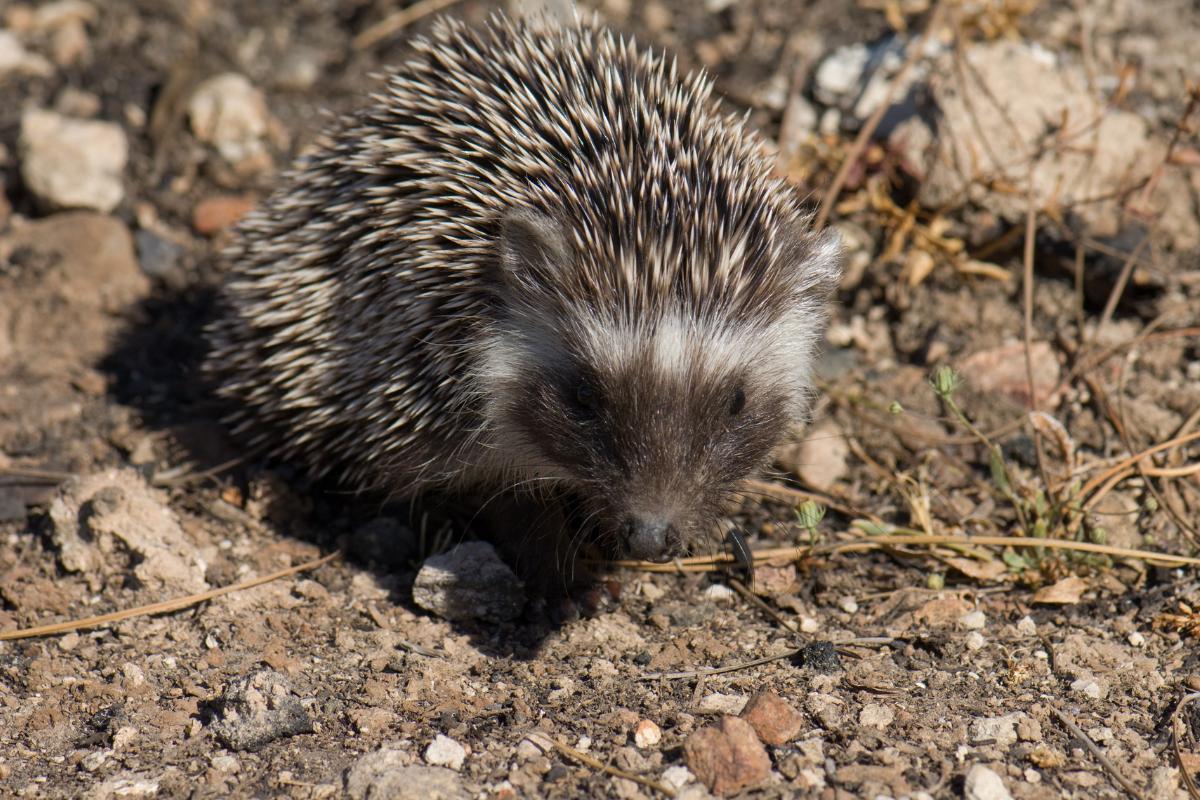Where Do Hedgehogs Live?


Hedgehogs, fascinating creatures known for their endearing appearance and unique spines, are found in various regions around the world. While their natural distribution is primarily concentrated in Africa, Asia, and Europe, hedgehogs have also been introduced to other regions due to their popularity as pets. In their native habitats, hedgehogs have adapted to a wide range of ecosystems and habitats. They can be found in woodlands, grasslands, shrublands, semi-deserts, and even urbanized areas.
The following AnimalWised article delves into the question of where hedgehogs live, exploring their various habitats and discussing the specific nests and burrows they construct for reproduction and protection.
Where are hedgehogs most commonly found?
Hedgehogs are native to specific regions of Africa, Asia, and Europe. They have adapted to various habitats within these regions, ranging from woodlands and grasslands to deserts and semi-deserts. Hedgehogs seek shelter in burrows, leaf litter, thick vegetation, or natural crevices for protection.
Additionally, some hedgehog species have adapted to living in human-modified landscapes, including gardens, parks, and agricultural areas.
Furthermore, some hedgehog species have been introduced to areas beyond their native ranges. For example, hedgehogs have been introduced to New Zealand, where they have become invasive and caused significant issues for local fauna. The uncontrolled growth of hedgehog populations in New Zealand has led to high levels of predation, which has negatively impacted native species and ecosystems.
Similarly, hedgehogs have been brought to certain parts of America, such as parts of North America, South America, and the Caribbean. These introductions have occurred either intentionally as pets or unintentionally through accidental releases or escapes.
In some countries, it has become popular to keep certain hedgehog species as pets. This has led to the breeding and marketing of specific types of hedgehogs, sometimes through hybridization or selective breeding to create new color variations or patterns. However, it's important to note that regulations regarding the pet trade and ownership of hedgehogs vary from country to country.
While keeping hedgehogs as pets may be legal and popular in some regions, it is restricted or prohibited in others. Some countries have implemented laws and regulations to limit the trade and ownership of hedgehogs as pets due to concerns about their welfare, potential impact on native wildlife, or issues related to their care requirements.
It's crucial for individuals interested in owning hedgehogs as pets to research and comply with the specific laws and regulations of their country or region to ensure that they are engaging in legal and responsible ownership practices.
Discover further insights and valuable information about keeping hedgehogs as pets by reading our other article on the subject.
What is the habitat of a hedgehog?
Hedgehogs inhabit a variety of habitats, and the specific species of hedgehog determines the type of ecosystem it can be found in. Each species of hedgehog has adapted to survive and thrive in its specific habitat, demonstrating their ability to inhabit diverse ecosystems across various regions of the world. Here is an overview of the habitats where different types of hedgehogs live:
North African hedgehog (Atelerix algirus)
Native to Algeria, Libya, Morocco, and Tunisia, this species thrives in various ecosystems such as semi-desert areas, dry scrublands, grasslands, crops, and even gardens. It can adapt to urbanized spaces.
Four-toed hedgehog (Atelerix albiventris)
Found in countries across West, Central, and East Africa, including Cameroon, Ethiopia, Ghana, Kenya, Sierra Leone, and more. It inhabits savannahs, grasslands, and areas with scrub vegetation.
European hedgehog (Erinaceus europaeus)
This species is found in countries like Austria, France, Germany, the United Kingdom, and many others. It lives in deciduous forests, forest edges, and grasslands, but is also commonly found in humanized areas such as orchards, vineyards, parks, and gardens.
Northern white-breasted hedgehog (Erinaceus roumanicus)
Native to countries like Austria, Poland, Russia, Turkey, and Ukraine, this species can be found in farmlands, parks, gardens, forest edges, and shrubby areas. It tends to have a greater presence in human-altered habitats.
Long-eared hedgehog (Hemiechinus auritus)
This species is native to regions including Afghanistan, China, Egypt, Iran, and Syria. It prefers habitats like steppes, semi-deserts, and deserts, and can be found in dry river valleys, ravines, forested areas, and near human settlements.
Indian long-eared hedgehog (Hemiechinus collaris)
Typically found in India and Pakistan, this species lives in deserts and semi-deserts but prefers areas near bodies of water. It may also have a presence in certain agricultural fields.
Daurian hedgehog (Mesechinus dauuricus)
Distributed in China, Mongolia, and Russia, this species inhabits steppes, taigas, grasslands with birches, poplars, willows, and pea bushes. It is commonly found near plantations and human settlements, selecting habitats close to water sources and food availability.
Hugh's hedgehog (Mesechinus hughi)
This species is endemic to China and is primarily found in regions with dry steppes or grasslands. A subspecies has been identified that is more restricted to mountainous areas.
Desert hedgehog (Paraechinus aethiopicus)
Native to several countries in Africa and the Middle East, including Algeria, Egypt, Saudi Arabia, and Somalia, this species is widespread in desert areas with oases and food sources. It also inhabits savannahs, scrublands, grasslands, and inland areas with wetlands.
Brandt's hedgehog (Paraechinus hypomelas)
Found in countries like Afghanistan, Iran, Oman, and Turkmenistan, this species prefers habitats such as fluvial and humid steppes, semi-deserts, and deserts.
For a comprehensive understanding of the various hedgehog species, we recommend exploring this other article on the most common types of hedgehogs.

Where do hedgehogs make their nests?
Hedgehog burrows, also known as hedgehog nests or dens, serve as essential shelters and nesting sites for these small mammals. Hedgehogs are capable of digging their own burrows using their strong front claws, although they often choose pre-existing burrows or natural cavities to establish their nests. These natural cavities can include holes beneath tree roots, rock crevices, or dense vegetation. Additionally, hedgehogs may utilize man-made structures like compost heaps, log piles, or brush piles.
The size of hedgehog burrows can vary depending on the species, habitat, and available resources. The entrance to the burrow is usually small, just enough for the hedgehog to squeeze through, typically measuring around 10 centimeters (4 inches) in diameter. The burrow itself may extend to a length of several meters and have multiple chambers.
The main chamber serves as a sleeping area and a safe spot for giving birth and raising young, while the tunnels provide additional protection and escape routes. The tunnels may branch out, allowing hedgehogs to move around and explore their surroundings.
Hedgehogs line their burrows with various materials to provide insulation and comfort. They collect leaves, grass, and other vegetation to create a soft nest within the burrow. This nest material helps regulate temperature, keeping the hedgehogs warm during cooler periods and providing a cozy environment for hibernation.
The burrows are designed to offer protection from predators and the elements. The intricate tunnel system and concealed entrances help keep hedgehogs safe from larger animals that may pose a threat.
Hedgehogs are not strictly territorial, and they may have multiple burrows within their home range. They use these burrows for various purposes, such as resting, hibernation, mating, and raising young. Having multiple burrows provides hedgehogs with alternative shelters and allows them to move between different areas.
Discover other fascinating facts about hedgehogs beyond their remarkable burrow-building abilities in this article.
If you want to read similar articles to Where Do Hedgehogs Live?, we recommend you visit our Facts about the animal kingdom category.
- Ciszek, D. and P. Myers. (2000). " Erinaceidae ". Animal Diversity Web. Available at: https://animaldiversity.org/accounts/Erinaceidae/
- ITIS. (2023). Erinaceinae . Available at: https://www.itis.gov/servlet/SingleRpt/SingleRpt?search_topic=TSN&search_value=633423#null
- IUCN. (2023). The IUCN Red List of Threatened Species. Version 2022-2. Available at: https://www.iucnredlist.org






